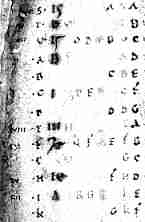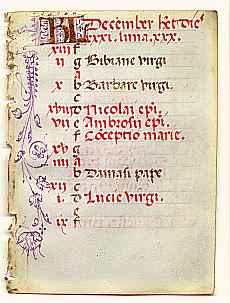



If you are looking at this page without frames, there is more information about medieval writing to be found by going to the home page (framed) or the site map (no frames).
| Reading a Calendar (3) | |||
 |
|||
| Segment from the page of the Julius Calendar and Hymnal shown earlier (British Library, Cotton Julius A VI, f.7b), by permission of the British Library. | |||
| The earlier example of an 11th century calendar is laid out slightly differently, and is a little more complex and harder to comprehend. For starters the calendar entries are in verse, with an enlarged initial slightly separated from the word at the beginning of each line. This is a convention of verse writing throughout the middle ages, but the column of capital letters is not to be confused with the rest of the esoteric code. | |||
 |
The Roman calendar entries are given in full, and you will note the truly confusing aspect of this form of dating is that the numbers work backwards. So starting from the top of this segment we have 6 nones, 5 nones, 4 nones, 3 nones, 2 nones and then nones itself (a little difficult to see as presumably it is written in red or gold). For this reason kalens comes after nones and ides, as it refers to kalens, or the first day, of the following month. So the 31st October is referred to as 2 kalens November. At the top of the column the enlarged letters KL refer to the kalens of October. Clear as mud, isn't it? | ||
 |
The Dominical Letters appear to the left of the Roman date, on the right of this segment. The Golden Numbers appear, very tiny and difficult to see, at the far left. In between is an assortment of letters in various rows and columns and what appears to be a column of Arabic numerals. I really don't know what that is about, but I have a sneaking suspicion that leap year calculations come in there somewhere. All knowledgeable suggestions will be gratefully received. | ||
 |
While the example above was most likely for the use of the clergy, and therefore contains all the technical dating apparatus, that on the left represents a much later work for the laity; a very tiny and modest book of hours. The more important saints' days are in rubric, others in ordinary brown ink. The golden numbers and dominical letters are there, but apart from the intials KL at the top of the page in gold leaf to indicate kalens, or the beginning of the month, there is no numbering of the days at all. One must assume that ordinary people in the 15th century measured time by the feasts of the saints, and not by numbers, as is found in many legal documents of the time. | ||
| Leaf showing the calendar page for December from a late 15th century Italian book of hours. From a private collection. | |||
| The calendar is therefore not just a simple listing of feast days and saints' commemorations. It reflects the concerns of different groups in society. It embodies tricky calculations which integrate several different systems of computing time. It also holds hidden information about the history of the medieval Christian church. | |||
|
|
|||
|
|
|||
|
|
|||
|
If you are looking at this page without frames, there is more information about medieval writing to be found by going to the home page (framed) or the site map (no frames). |
|||